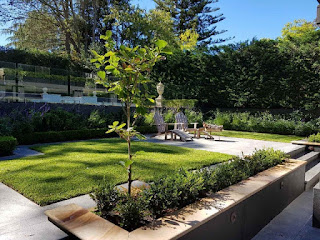What are a Retaining wall and its types?
It's called a retaining wall since it's a freestanding construction constructed to hold back the dirt. It's only possible to pile dirt at this angle without it collapsing. A retaining wall can be used when the intended elevation change exceeds the angle of repose. A dirt "wedge" is held in place by a retaining wall.
It's a wedge of all the soil from the retaining wall to the plane at which it would naturally lie without the wall. A wall's setback, or the angle at which it tilts toward the soil, can be increased by landscapers to lessen the pressure it is under. landscaping northbridge provides all types of retaining walls.
Types of retaining wall
1 Gravity Retaining Walls The mass of gravity retaining walls acts as a barrier to keep the retained earth in place. You can easily check Retaining wall design to learn about retaining wall design principles and the reason for failure. Stone is filled into wire baskets to create gabion basket retaining walls. Baskets are constructed of galvanized wire which is coated in plastic and stainless steel wire. They're usually 1m x 1m x 2m long. Gravity retaining walls which are made of concrete block interlocking blocks are a common sight. it comes to size and length, the concrete blocks typically come in two sizes: 600 x 600mm or 800 x 800mm which is the width and 800x800mm is the height. Gravity retaining walls that lean into the retaining ground are comparable to flat gravity retaining walls. The incline has a 15-degree inclination to it.
2Cantilever retaining walls are these are L in shape Earth or other materials have been deposited on the bottom section's lengthy leg. It Helps the design because of the weight of this earth or other material on top of it. This needs less material to build the wall. These walls are built from Reinforced Concrete, Reinforced Concrete Blocks, and piles.
3 Criblock retaining walls: Gravity retaining walls and Criblock retaining walls have a lot in common. Frame construction is used to erect these structures. Because of the notches on the frames, they can be joined together. Headers are available in lengths of 600mm, 900mm, 1200mm, and 1500mm, and that can be stretchers lengths of 1.2m and 2.4m long. As the wall takes shape, the stone is poured into the frames to give them further weight. Incorporating treated wood, pre-cast concrete, and recycled plastic into their design is one option.
4 Reinforced soil retaining walls
Soil retention walls are built utilizing the retained soil. Unless the retaining soil is sufficient, this can't be done Designing reinforced earth retaining walls geotechnical engineers. The retaining wall is constructed in stages. A geotechnical reinforcement is applied to each stratum. Like plastic bunting, but intended to withstand tensile forces, this type of material is available. To speak to an expert in this area contact landscaping north willoughby
Conclusion:
With large rocks, baskets filled with small rocks, treated timber, and cast-in-place concrete and concrete blocks, a retaining wall is constructed.


Comments
Post a Comment